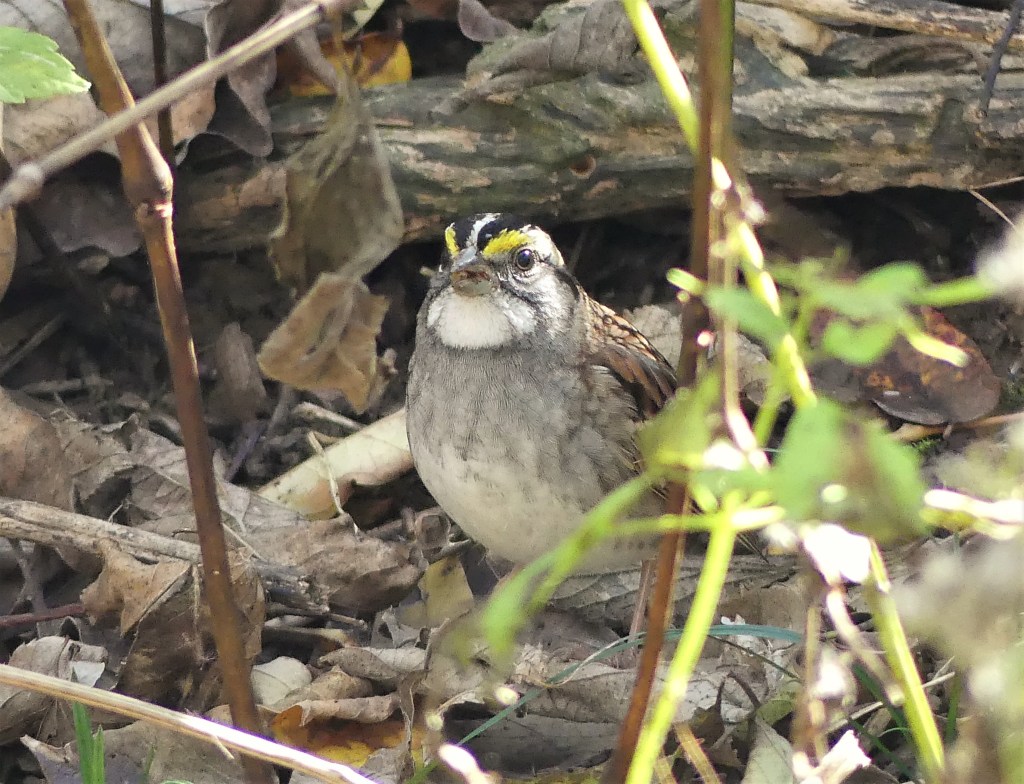
The season of easy bugs is over; flycatchers, tanagers, swifts and swallows have all headed south. But a new wave of avian eaters recently arrived, and there’s still plenty of food in the forest for those adapted to use it.

Much of the forest understory can now be described as densely weedy – in a good way. More sunlight reaching the ground has led to an explosion of two plants in particular, White snakeroot and Wingstem, both valuable for seed eating birds.

For the last couple of weeks, little bands of White-throated sparrows, Song sparrows and Eastern towhees have been drifting through the brushy cover, giving up their presence with much dry rustling and snippets of “old sam peabody, peabody…”


In contrast to the seed eaters, food does not just fall into the beaks of gleaners. The hardy Yellow-rumped warbler is one of just a handful of migratory insectivores that linger here in winter. Though large insects are dormant, plenty of tiny critters and eggs can still be found be found on leaves, stems and bark.


Due to the great number of declining old trees, avian bark gleaners are abundant as both residents and winter visitors; their foraging activity is much easier to observe when the leaves are off. My favorite has to be the cryptically patterned Brown creeper, a bird no one would never see at all but for the fact that it’s always creeping.


Many birds that rely on insects, worms or arthropods in summer switch up their diet seasonally, including more fruits when insects are scarce.

Though robins spend a lot of time digging for earthworms when the ground isn’t frozen, they’re also serious frugivores. Because of their large populations, robins are the main dispersers of the berries of invasive plants in eastern forests. These days it’s a pleasure to watch them ingesting the berries of native Spicebush, Greenbriar, and Wahoo.

Even Pileated woodpeckers enjoy fruits, finding them on high climbing vines like Poison ivy, Virginia creeper and Wintercreeper.

Whistling flocks of sleek Cedar waxwings are also wandering through, on the hunt for late season berries.

The most interesting foraging behavior I’ve observed this fall has to be the “hover gleaning” practiced by Ruby-crowned kinglets. While following one of these non-stop little dynamos with my camera, I caught it in midair leaping to pluck some tiny creature from a leaf!
.
.
.
.
.
.
.
.
.

Ann Rosa
As usual, amazing pictures and great descriptive picture of what is occurring. Can’t wait for the next installment!!
LikeLiked by 1 person
oneforestfragment
Thank-you Ann – the birding is great lately in this little forest!
LikeLike
Chet Wright
I’m always amazed at your bird photos. Mine always look like blurry splotchets, if I’m lucky enough to get anything at all.
LikeLiked by 1 person
oneforestfragment
Thanks Chet! It is for sure a learning experience, but I have to credit the relatively abundant and approachable bird life in this little forest. And my recently acquired Panasonic FZ300 camera. It’s not an SLR, but has a decent zoom and a very useful “pinpoint focus area” setting that makes bird photos possible. That, and a ton of photo editing for pumping up the image clarity!
LikeLike
oneforestfragment
By the way, I really enjoy reading about your adventures in the beautiful southern mountains!
LikeLike
shoreacres
I always learn something about my world from your posts. I didn’t realize that greenbriar has berries! I had to look up ‘frugivore,’ too. As it turned out, I’d figured it our correctly, but now I’m sure.
I do love the waxwings. They appear here on rare occasion; one year, I watched a flock of them strip the fruits from the palm trees around my place. It took only three days, and then they were gone. Migration’s going full tilt just now. Today, I saw at least two hundred more white pelicans wheeling in, and I began hearing the goldfinches. They’ll hang around even residential areas, because of the crape myrtles. The seeds are ripening now, and it’s a good place to look for the birds.
LikeLiked by 1 person
oneforestfragment
Living in such a landlocked region, I’ve rarely seen pelicans. To see two hundred and more at a time must be breathtaking!
LikeLike